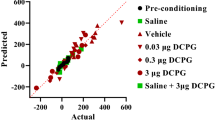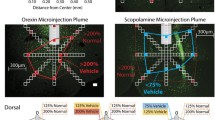Abstract
Experiments were conducted to examine the ability of the selective 5-hydroxytryptamine (5-HT)1A agonist 8-hydroxy-2-(di-n-propylamino)tetralin (8-OH-DPAT) to induce a conditioned place preference following peripheral injection, and direct microinjection into the dorsal or median raphe nuclei. An unbiased place preference paradigm was used in which control animals showed no preference for either of two compartments differing in terms of colour (white versus black), floor texture (rough versus smooth) and olfactory cues (no odour versus acetic acid odour). Drug treatments were paired with access to either of the two compartments, and saline injections were paired with access to the other compartment. Rats experiencing a low dose of 8-OH-DPAT (125 µg/kg) with a specific compartment demonstrated a significant preference for that compartment over one paired with saline injections. The magnitude of this effect was similar to that observed in rats treated with 1.5 mg/kgd-amphetamine. A significant place preference was found in animals receiving injections of 8-OH-DPAT in the dorsal raphe at 0.1 µg but not 1 µg. Animals also displayed a preference for the compartment paired with 1 µg 8-OH-DPAT injected into the median raphe; lower doses were not effective. These results indicate that the mechanism by which 8-OH-DPAT induces a conditioned place preference involves activation of raphe somatodendritic 5-HT1A autoreceptors, leading to a reduction in 5-HT neurotransmission. This demonstration of the rewarding properties of 8-OH-DPAT, together with previous results showing increased feeding and sexual behaviour following 8-OH-DPAT treatment, strongly suggests an important role for brain 5-HT systems in reward and reinforcement processes.
Similar content being viewed by others
References
Ahlenius S, Larsson K, Svensson L, Hjorth S, Carlsson A, Lindberg P, Wikstrom H, Sanchez D, Arvidsson L-E, Hacksell U, Nilsson JLG (1981) Effects of a new type of 5-HT receptor on male rat sexual behavior. Pharmacol Biochem Behav 15:785–792
Azami E, Llewelyn J, Roberts MHT (1980) An extra-fine assembly for intracerebral microinjection. J Physiol (Lond) 305:18–19
Azmitia EC (1978) The serotonin-producing neurons of the midbrain median and dorsal raphe nuclei. In: Iversen LL, Iversen SD, Snyder SH (eds) Handbook of psychopharmacology, vol 9. Plenum Press, New York, pp 233–314
de Belleroche JS, Gardiner IM (1982) Contrasting effects of 5-hydroxytryptamine on the release of dopamine and acetylcholine in the nucleus accumbens. J Neural Transm 55:227–242
Bendotti C, Samanin R (1986) 8-Hydroxy-2-(di-n-propylamino)tetralin (8-OH-DPAT) elicits eating in free feeding rats by acting on central serotonin neurons. Eur J Pharmacol 121:147–150
Blier P, Serrano A, Scatton B (1990) Differential responsiveness of the rat dorsal and median raphe 5-HT systems to 5-HT1 receptor agonists andp-chloroamphetamine. Synapse 5:120–133
Carr GD, Fibiger HC, Phillips AG (1989) Conditioned place preference as a measure of drug reward. In: Liebman JM, Cooper SJ (eds) The neuropharmacological basis of reward. Oxford University Press, Oxford, pp 264–319
Connor HE, Higgins GA (1990) Cardiovascular effects of 5-HT1A receptor agonists injected into the dorsal raphe nucleus of conscious rats. Eur J Pharmacol 182:63–72
Davies M, Sloley BD, Fletcher PJ (1989) Neurochemical, electrophysiological and behavioural evidence that 8-OH-DPAT stimulates central dopamine systems. Soc Neurosci Abstr 15:553
Dourish CT, Hutson PH, Curzon G (1985) Low doses of the putative serotonin agonist 8-hydroxy-2-(di-n-proplyamino)tetralin (8-OH-DPAT) elicit feeding in the rat. Psychopharmacology 86:197–204
Dray A, Davies J, Oakley NR, Tongroach P, Vellucci S (1978) The dorsal and medial raphe projections to the substantia nigra in the rat: electrophysiological, biochemical and behavioural observations. Brain Res 151:431–442
Drescher K, Hetey L, Fink M (1988) Serotonin and dopamine release from synaptosomes of the nucleus accumbens after systemic or intra-raphe administration of LSD to rats. Biogenic Amines 5:93–102
Fletcher PJ (1991) Dopamine receptor blockade in nucleus accumbens or caudate nucleus differentially affects feeding induced by 8-OH-DPAT injected into dorsal or median raphe. Brain Res 552:181–189
Fletcher PJ (1993) A comparison of the effects of dorsal or median raphe injections of 8-OH-DPAT in three operant tasks measuring response inhibition. Behav Brain Res 54:187–197
Fletcher PJ, Davies M (1990) A pharmacological analysis of the eating response induced by 8-OH-DPAT injected into the dorsal raphe nucleus reveals the involvement of a dopaminergic mechanism. Psychopharmacology 100:188–194
Guan X-M, McBride WJ (1989) Serotonin microinfusion into the ventral tegmental area increases accumbens dopamine release. Brain Res Bull 23:541–547
Higgins GA, Elliott P (1991) Differential behavioural activation following intra-raphe infusion of 5-HT1A receptor agonists. Eur J Pharmacol 193:351–356
Higgins GA, Bradbury AJ, Jones BJ, Oakley NR (1988) Behavioural and biochemical consequences following activation of 5-HT1-like and GABA receptors in the dorsal raphe nucleus of the rat. Neuropharmacology 27:993–1001
Hillegaart V (1991) Effects of local application of 5-HT and 8-OH-DPAT into the dorsal and median raphe nuclei on core temperature in the rat. Psychopharmacology 103:291–296
Hillegaart V, Ahlenius S, Larsson K (1989) Effects of local application of 5-HT into the median and dorsal raphe nuclei on male sexual and motor behavior. Behav Brain Res 33:279–286
Hillegaart V, Hjorth S, Ahlenius S (1990) Effects of 5-HT and 8-OH-DPAT on forebrain monoamine synthesis after local application into the median and dorsal raphe nuclei of the rat. J Neural Transm 81:131–145
Hjorth S, Magnusson T (1988) The 5-HT1A receptor agonist, 8-OH-DPAT, preferentially activates cell body autoreceptors in rat brain in vivo. Naunyn Schmiedeberg's Arch Pharmacol 338:463–471
Hutson PH, Dourish CT, Curzon G (1986) Neurochemical and behavioural evidence for mediation of the hyperphagic action of 8-OH-DPAT by 5-HT cell body autoreceptors. Eur J Pharmacol 129:347–352
Invernizzi R, Carli M, Di Clemente A, Samanin R (1991) Administration of 8-hydroxy-2-(di-n-propylamino)tetralin in raphe nuclei dorsalis and medianus reduces serotonin synthesis in the rat brain: differences in potency and regional sensitivity. J Neurochem 56:243–247
Jiang LH, Ashby CR, Kasser RJ, Wang RY (1990) The effect of intraventricular administration of the 5-HT receptor agonist 2-methyl-serotonin on the release of dopamine in the nucles accumbens: an in vivo chronocoulometric study. Brain Res 513:156–160
Kosofsky BE, Molliver ME (1987) The serotonergic innervation of the cerebral cortex: different classes of axon terminals arise from dorsal and median raphe nuclei. Synapse 1:153–168
Loh EA, Roberts DCS (1990) Break-points on a progressive ratio schedule reinforced by intravenous cocaine increase following depletion of forebrain serotonin. Psychopharmacology 101:262–266
Montgomery AMJ, Rose IC, Herberg LJ (1991) 5-HT1A agonists and dopamine; the effects of 8-OH-DPAT and buspirone on brain-stimulation reward. J Neural Transm 83:139–148
Muscat R, Montgomery AMJ, Willner P (1989) Blockade of 8-OH-DPAT-induced feeding by dopamine antagonists. Psychopharmacology 99:402–408
Neisewander JL, McDougall SA, Bowling SL, Bardo MT (1990) Conditioned taste aversion and place preference with buspirone and gepirone. Psychopharmacology 100:485–490
Papp M, Willner P (1991) 8-OH-DPAT-induced place preference and place aversion: effects of PCPA and dopamine antagonists. Psychopharmacology 103:99–102
Paxinos G, Watson C (1986) The rat brain in stereotaxic coordinates, 2nd edn. Academic Press, New York
Shippenberg TS (1991) Conditioned reinforcing effects of 8-hydroxy-2-(di-N-propylamino)tetralin: involvement of 5-hydroxytryptamine1A and D1 dopamine receptors. Neurosci Lett 121:136–138
Sinton CM, Fallon SC (1988) Electrophysiological evidence for a functional difference between subtypes of the 5-HT1 receptor. Eur J Pharmacol 157:173–181
Smith JE, Shultz K, Co C, Goeders NE, Dworkin SI (1987) Effects of 5,7-dihydroxytryptamine lesions of the nucleus accumbens on rat intravenous morphine self-administration. Pharmacol Biochem Behav 26:607–612
Tricklebank MD, Forler C, Fozard JR (1984) The involvement of subtypes of the 5-HT1 receptor and of catecholaminergic systems in the behavioural response to 8-hydroxy-2-(di-N-propylamino)tetralin in the rat. Eur J Pharmacol 106:271–282
Verge D, Daval G, Marcinkiewicz M, Patey A, El Mestikaway M, Gozlan H, Hamon M (1986) Quantitative autoradiography of multiple 5-HT1 receptor subtypes in the brain of control or 5,7-dihydroxytryptamine-treated rats. J Neurosci 6:3474–3482
Wieland S, Goodale D, Lucki I (1989) Behavioral studies of 8-OH-DPAT: studies using the microtaxic ventricular injector. J Neurosci Methods 30:151–159
Winer BJ (1971) Statistical principles in experimental design, 2nd edn. McGraw Hill, New York
Wise RA (1987) The role of reward pathways in the development of drug dependence. Pharmacol Ther 35:227–263
Wogar MA, Bradshaw CM, Szabadi E (1991) Evidence for an involvement of 5-hydroxytryptaminergic neurones in the maintenance of operant behaviour by positive reinforcement. Psychopharmacology 105:119–124
Author information
Authors and Affiliations
Rights and permissions
About this article
Cite this article
Fletcher, P.J., Ming, ZH. & Higgins, G.A. Conditioned place preference induced by microinjection of 8-OH-DPAT into the dorsal or median raphe nucleus. Psychopharmacology 113, 31–36 (1993). https://doi.org/10.1007/BF02244330
Received:
Revised:
Issue Date:
DOI: https://doi.org/10.1007/BF02244330




